English Pouter Pigeon: History And Breed Guide
The English Pouter Pigeon is an unprecedented bird that has captured the hearts of bird enthusiasts around the world with its remarkable avian beauty.
With its distinctive appearance and captivating behavior, the English pouter is a true testament to the wonders of nature. While they are mainly used for show purposes, they have some amazing qualities for which you can make them ideal pets.
But wait, that’s not all!
There is more to discover about this pigeon. In this article, we will take a closer look at their history, unique features, breeding and raising process, and many more.
So, keep scrolling as we are about to start.
Interested in similar topics on pigeon breed:
English Pouter Pigeon Profile
| Name | English Pouter Pigeon |
|---|---|
| Scientific Name: | Columbia livia domestica |
| Common Names: | 1. English Pouter 2. Pouting Horseman (historically) |
| Origin: | England |
| Size: | Small to large |
| Weight: | 350g – 950g |
| Lifespan: | 7-10 years |
| Physical Features: | Dove-shaped head, Inflated crop, V-shaped long narrow waist, slender wings, long feet covered with feathers |
| Temperament: | Gentle |
| Behavior: | Friendly |
| Special Features: | Elongated inflated crop, long V-shaped waist |
| Breeding and Maintenance: | Easy breeding Low maintenance |
| Common or Popular Varieties: | Black, Blue check, Red, Blue, Yellow, Almond, Dun and Andalusian |
Overview of English Pouter Pigeon
The English Pouter pigeon is the result of selective breeding. It was named according to its place of origination (England) and the noblest feature, the “pout.”
But historically, it was also called the Pouting Horseman. This is because it has a close tie-up with the Horseman breed.
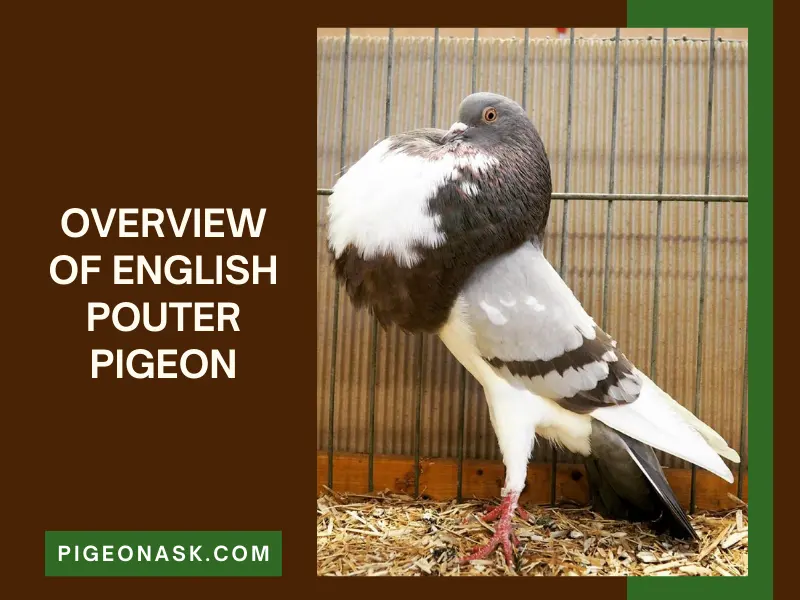
The primary purpose of these pigeons to breed has always been exhibition. Yet, due to its captivating and tame behavior, pigeon enthusiasts love to have them as pets.
Plus, its amazing regal appearance can make you fall in love with this breed any day.
The English Pouter, a breed with an enormous inflated crop, is the descendant of the Rock Pigeon.
Their appearance is so unique that Charles Darwin, a world-famous naturalist, geologist, and biologist, mentioned its name in his well-known book The Variation of Animals and Plants Under Domestication (1868).
History And Origins of English Pouter Pigeons
The history of the English Pouter traces back to the early 17th century in England. During this time, pigeon fancying was a popular pastime among the British elite group.
The exact origins of the breed are somewhat shrouded in mystery. Regarding the origins, there is a mixed opinion among different naturalists.
For instance, according to William Bernhardt Tegetmeier, the English Pouter was born due to the cross-breeding of the Parisian Pouter, Dutch Cropper, and Uploper (old breeds from the 17th century).
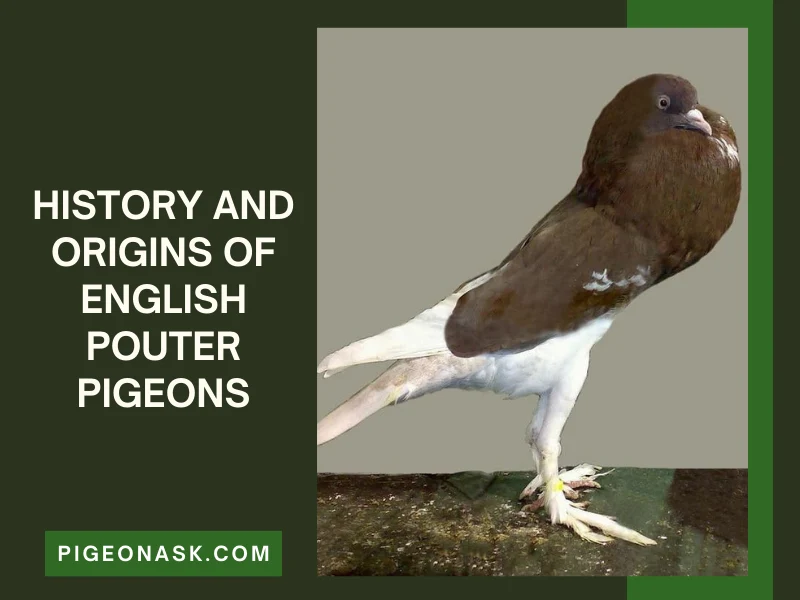
On the other hand, John Moore claimed that the breed originated from the cross-breeding of 18th-century pigeons called Cropper and Horseman. That’s why the English Pouter was called Pouting Horseman historically.
Now, the question is how they were bred and developed. Well, the development involved careful breeding practices.
Breeders meticulously choose pigeons with desired traits, which include a pronounced pout, graceful posture, and distinct plumage colors.
The goal was to achieve a breed that would not only win the show arena but also win the hearts of bird enthusiasts with its amazing pout and other desirable characteristics.
Physical Characteristics And Features
The English Pouter is well-known for its appearance and posture. However, here is a more elaborated version of their physical characteristics and features.
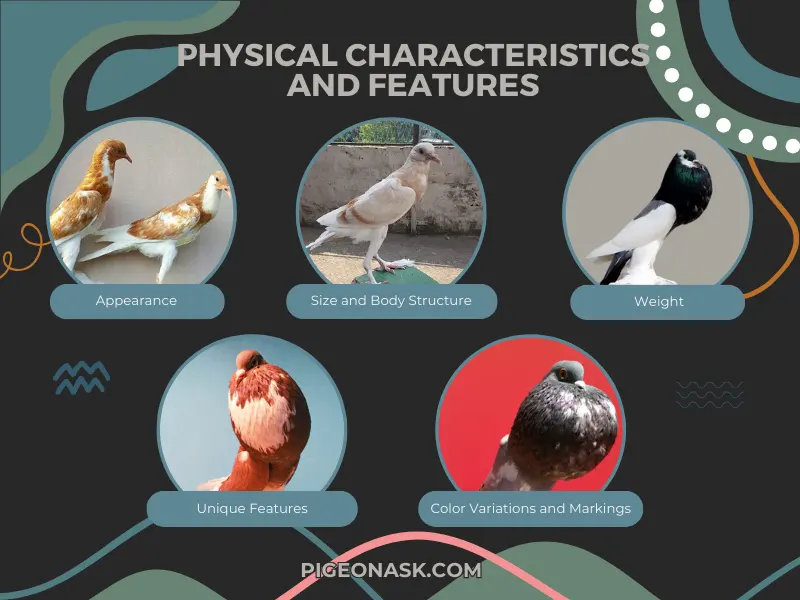
Appearance
This domesticated pigeon breed possesses a large body with an enormous inflated crop. They hold themselves in a certain posture that can be defined as regal.
The head of the English Pouter is comparatively smaller than the body ratio. And the shape of the head is similar to a dove’s head.
Talking about their waist, it is pretty long compared to other domestic pigeon breeds. It has a distinct V-shape look. Plus, it is surprisingly slender and approximately one-third of the length of the bird.
The English Pouter have strong and long legs, which help them to be the tallest among all pouter breed variety and the majority of the length comes from the knee to the feet.
And the feet are mostly covered with feathers, giving them a unique graceful look.
Their wings are narrow and much closer to the body. Plus, they carry them high while maintaining an elegant look.
Due to their monarchical appearance, Charles Darwin, in his 1868 work The Variation of Animals and Plan Under Domestication, described that the English pouter was “Perhaps the Most Distinct of All Domesticated Pigeons.”
Size and Body Structure
The English Pouter pigeon is available in small to large sizes. And the average body height of the smaller one is 12 inches, while the bigger one has an average height of 16 inches.
However, their slim, elongated body shape and well-balanced proportions contribute to their overall grace. Plus, the puffed-up and well-rounded crop is an amazing addition to their conformation.
Weight
The weight of English pouter ranges from 350 grams to 950 grams. And the smaller version of the English Pouter, which is well-known as the Pigmy Pouter pigeon, weighs around 350 grams with an average body height of 30 centimeters.
Consequently, the bigger one, or the English Pouter, can weigh up to 950 grams with an average height of 40 centimeters.
Unique Features
The English Pouter’s most distinct and mentionable feature, the “pout,” is what sets it apart.
This peculiar characteristic of puffing out its crop (the part of the digestive system where food is temporarily stored) also gave rise to its name, “Pouter.”
And how can we forget about the long, slender, and V-shape waist, which is a significant part of their whole body length?
Because of these two features, they have become a subject of utter attention to the pigeon lovers like you.
Some Common Variations in Colors and Markings
English Pouter Pigeons come in a manifold, beautiful and popular color varieties. Here are some common and popular varieties of these adorable pigeons –
| Color | Description |
|---|---|
| Black | Predominantly black with a glossy sheen. Classic choice. |
| Red | Rich reddish-brown coloring, warm and inviting. |
| Blue | Soft blue-gray coloration on feathers, soothing and captivating. |
| Yellow | Bright and sunny yellow plumage, cheerful and eye-catching. |
| Silver | Silvery sheen to feathers exudes elegance and sophistication. |
| Almond | Mottled pattern with a combination of colors, resembling almonds. |
| Dun | Gray-brown coloring is subtle and attractive. |
| Andalusian | Bluish-gray with a hint of lavender, delicate and appealing. |
Distribution And Habitat of English Pouter Pigeons
As the English Pouter is a domesticated breed, they are often found in a human-controlled environment. However, let’s take a closer look at their habitual preferences.
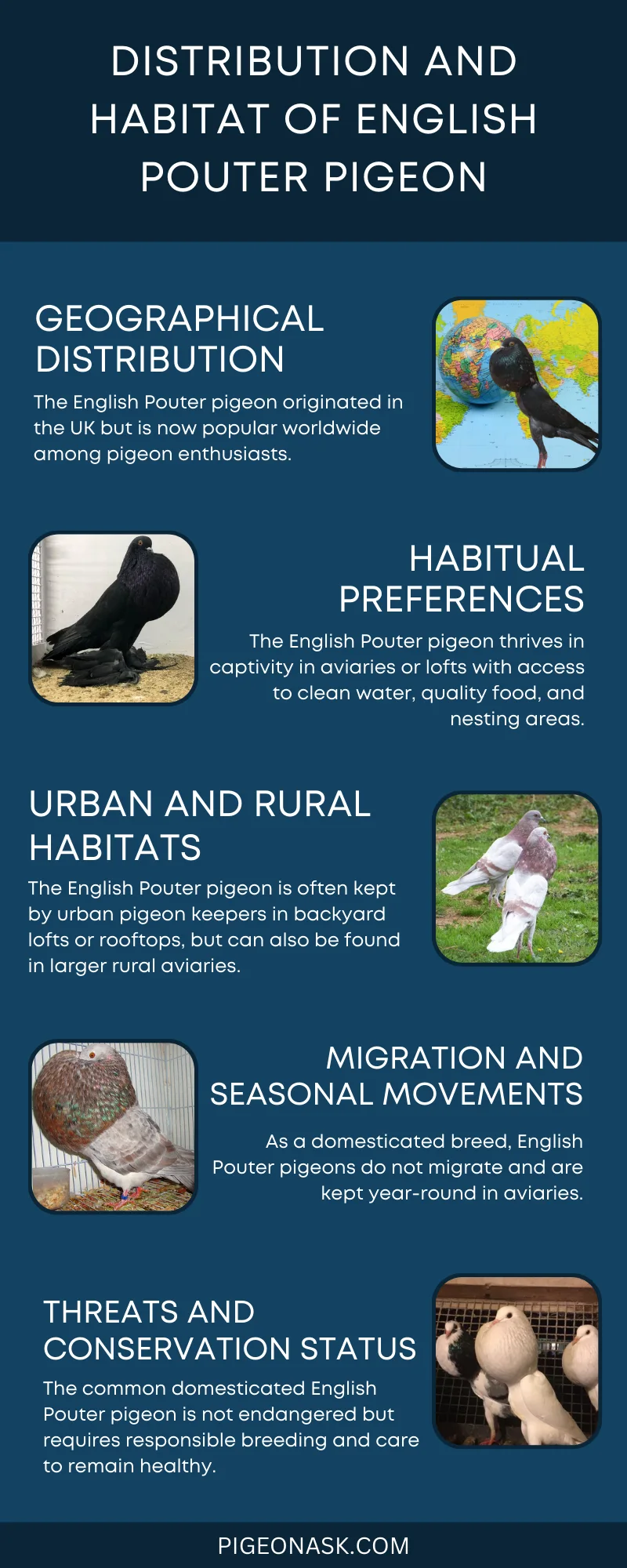
Geographical Distribution
These birds primarily hail from the United Kingdom, where it has been bred for centuries. But now, their influence extends beyond their homeland due to their uniqueness.
You can find them now worldwide wherever pigeon enthusiasts and breeders exist.
Habitual Preferences
You see, the English Pouter pigeons are home-bred. They are typically kept in a well-maintained aviary or lofts by the pigeon fanciers.
These pigeons thrive in captivity where there is access to clean water, quality food sources, and suitable nesting arrangements.
Urban and Rural Habitats
Though the English Pouter can adapt to both urban and rural settings, they are often found in urban areas.
Pigeon keepers who appreciate their beauty keep them in the backyard lofts or on rooftops with proper access to all essential facilities.
On the other hand, in rural settings, you may find them in larger aviaries on private properties.
Migration and Seasonal Movements
Unlike many wild bird species, these pigeons do not engage in any long-distance migratory or seasonal movements. As they are bred and raised in captivity, they are kept confined in their aviaries throughout the year.
Threats and Conservation Status
Since the pouters are a common and domesticated breed, they are neither endangered nor threatened.
However, like all domestic breeds, they are vulnerable to diseases, parasites, and predation if you do not provide them with a secure and well-nourished environment.
Plus, responsible breeding practices and proper care are necessary to keep them healthy and happy.
Behavior And Traits of English Pouter Pigeons
Here, we have described the common personality traits and behavior of the English pouter pigeons.
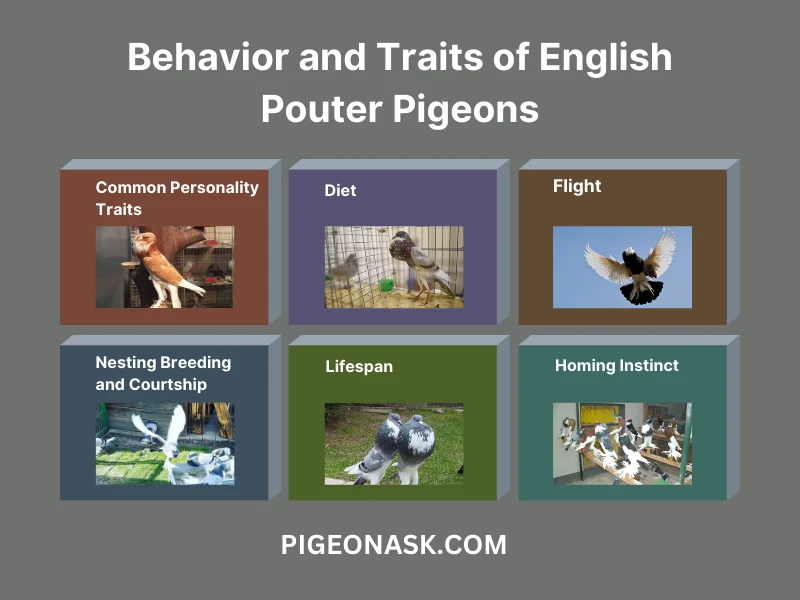
Common Personality Traits
These birds are renowned for their calm and gentle disposition. They are generally docile and well-behaved.
If you take care of them properly, they will remain loyal to you. Plus, as English Pouter pigeons do not engage in any aggressive activities and can coexist with another breed in the lofts, you can have them without being worried.
Their easygoing nature is also a plus point if you are willing to breed them as pets. They are social and approachable birds, which makes them easy to handle.
Diet
Just like the other 30 fancy pigeon species, the English Pouter likes to munch on grains, seeds, and pellets.
In case you want to offer a more balanced diet, you can add vegetables and fruits to their dietary plan. But what are the possible veggie options?
Well, anything that is leaves and easier to much on can be a good veggie treat for them. Vegetables like lettuce, spinach, cabbage, cauliflower, kale, broccoli, etc. are convenient options.
Plus, to ensure protein intake, you can provide small insects and worms occasionally.
Flight
While English Pouter pigeons are capable of flight, they are not well known for their flying abilities.
Their unique long and slender bodies with inflated crops are more appropriate for perching and posing rather than agile flight.
Nesting Breeding and Courtship
When it comes to the breeding process, the English Pouter pigeons are naturally great breeders.
They prefer the early spring and summer as their breeding time. This is because during this time, they get enough natural light and the days are much longer.
The male pigeon puffs up their crop to attract females. After they pair up, they start their nesting process. At this time, you can help them by providing enough straws, hay, and twigs.
Also, provide enough space in the lofts for each pair so that they can easily move around and create their desired nesting. Make sure the whole nesting area is dry and clean, otherwise, vital diseases or parasites can spread.
Once the birds finish their nesting, the female Pouter typically lays two eggs and it takes around 18 days to hatch their eggs. During this time, the parent pigeon maintains their incubation duties in turn.
After 4 to 6 weeks of hatching, the adorable pigeon babies are ready to be separated and live on their own.
Lifespan
Typically, the English Pouter pigeon has a lifespan of seven to ten years. However, if you can ensure proper care, nourishment, regular vet checkups, and other essential facilities, you can make them live longer.
Homing Instinct
Like the racing pigeon breeds, the English Pouter does not have a strong homing instinct. But if we take the Horseman Thief Pouter as an instance, they reflect amazing homing abilities.
However, if you train the English pouter for a while, it can show some promising results regarding this and become an excellent pet. Yet, they are mainly bred and known for their appearance and personality.
Breeding And Maintenance
Now, if you want to breed them successfully, take a careful look at the following instructions.
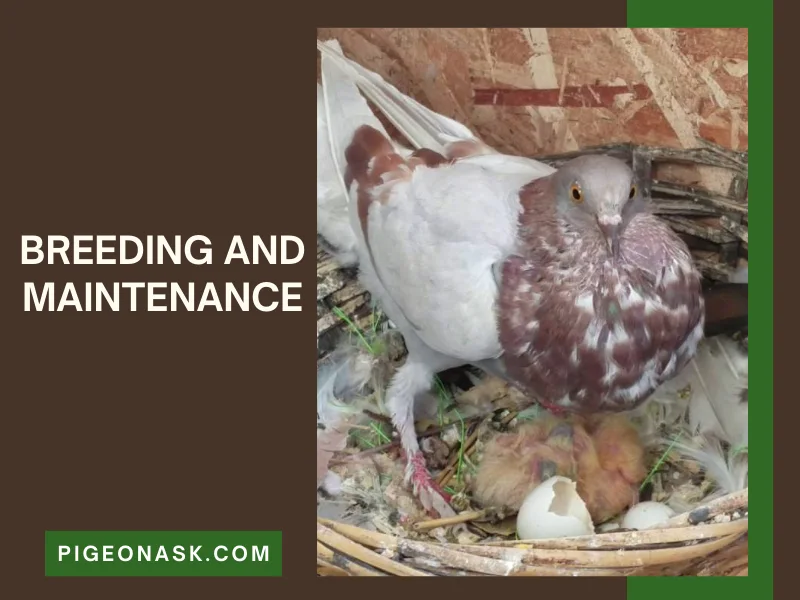
Information about Raising and Breeding
The English Pouter breeding and raising requires careful attention to detail.
And the first and foremost thing to consider is the breeding time, which is typically in the summer and at the beginning of the spring.
Then, you need to make sure you have a pair of healthy and compatible pigeons. Plus, double-check to ensure they have your desirable characteristics in them.
This part is quite critical and significant because the quality and overall appearance of the offspring depend on it.
Afterward, provide a platform or nesting boxes filled with nesting materials and sufficient space. Once the female lays the egg, both parents take turns incubating them.
After hatching, the parents take care of their offspring until they are mature enough to live on their own. So, be patient and let the parents do their job.
Some Tips and Considerations for Successful Breeding
If you are breeding the pigeons properly, it can be a rewarding experience. Here are some tips to make your breeding successful –
- Monitor the health of your pigeons regularly.
- Ensure a balanced diet, including sufficient vitamins, minerals, carbohydrates, fat, and protein.
- Maintain a suitable temperature (98.6°F to 100.4°F) and humidity level in their habitat.
- You must minimize the disturbance during the incubation and nesting.
- Keep records of breeding dates and hatching to track their progress.
- Finally, be prepared for any potential challenges like health issues.
Feeding and Housing Requirements
Proper feeding and housing are crucial for your Pouters to keep them happy and healthy. Just like every other pigeon breed, they require nutritious food and clean water resources.
You can provide them with a rich diet filled with seeds, grains, vegetables, and fruits like berries twice a day. Once in the morning and once in the night. The water supply should be consistent and should also be provided twice a day.
Keep a keen eye on their food habit and replace the water and food containers regularly to prevent contamination.
As for housing, you need to give them a loft or aviary with ample perching space where they can spread their wings without any disturbance.
Plus, as they have bigger body height, the regular housing space of pigeons won’t work with them. So, you better give more attention to that.
Another vital thing to take into account is the ventilation. You must include proper ventilation to maintain the air quality and protect them from extreme weather.
Oh! Let’s not forget about the nesting boxes. It should be available for every breeding pair. Make sure to disinfect them daily to maintain a hygienic environment for your Pouters.
Final Words
In a nutshell, English Pouter pigeons are a captivating and elegant breed. With their distinctive pout, gentle temperament, and graceful monarchial posture, they have stood out in the world of domesticated pigeons.
Born from centuries of selective breeding, they are a delightful choice for those who appreciate avian beauty and want a stunning-looking pet with a pleasant nature.
That’s all for today. We highly appreciate you for staying with us. If you find this article helpful, please do share. And follow us on our socials Facebook, Twitter and Pinterest for more informational pieces about the bird world.
